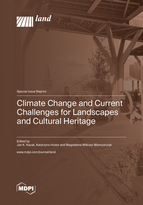Climate Change and Current Challenges for Landscapes and Cultural Heritage
A special issue of Land (ISSN 2073-445X). This special issue belongs to the section "Landscape Ecology".
Deadline for manuscript submissions: closed (30 September 2022) | Viewed by 33383
Special Issue Editors
Interests: sustainable cities and regions; adaptation to climate change; environmental impact assessment; natural resource management; resilience; urban design and planning
Special Issues, Collections and Topics in MDPI journals
Interests: spatial analysis; urban planning; city planning; landscape architecture; protection heritage; landscape planning; landscaping; landscape; cultural landscapes; landscape design; landscape urbanism; landscape aesthetics; urbanism; heritage conservation; landscape history
Special Issues, Collections and Topics in MDPI journals
Interests: suburbanization; semiurbanization processes; revitalization processes; garden art; urban design; planning; heritage; landscape; cultural landscapes; rural landscape
Special Issues, Collections and Topics in MDPI journals
Special Issue Information
Dear Colleagues,
This Special Issue will serve as a platform for the exchange of experiences among participants of the 28th conference in the series of garden art and historical dendrology titled “Climate Change and Current Challenges for Landscapes and Cultural Heritage”. This year, we would like to focus on an important discussion related to the climate change taking place in the world, with the identification of current problems and challenges in maintaining and preserving the cultural heritage of cities, villages, and open spaces. Raising this issue may significantly increase the awareness of the benefits associated with the protection of historical heritage and the vulnerability of and hazard to these monuments. We would like to focus on tangible cultural heritage, which includes cultural landscapes, historical buildings and gardens, archaeological sites, and historical sites. It is worth noting that such heritage plays an important role in economic, tourist, and recreational development, bringing significant benefits at the social, environmental, and economic level.
Climate change affects regions around the world and is associated with changes in average climate factors, as well as extreme weather events (e.g., storms, floods, heat waves). Moreover, an additional factor is the development of urban areas, which contributes to lowering the quality of water, increasing the number of impermeable surfaces, and creating urban heat islands. As the reports of IPCC (2019) and ICOMOS (2019) show, unfavorable phenomena may also threaten the survival of cultural heritage in the future. There are shortcomings in the policy of adaptation to climate change for heritage and shortages of technical guidelines in individual countries, which may contribute to the loss of valuable landscapes in the coming years. As stated in the March 2021 European Cultural Heritage Green Paper, “we firmly believe therefore that cultural heritage is a vector for achieving the long-term vision and policy goals of the European Union, including the European Green Deal. Cultural heritage is not just about preserving our past – it is about shaping our future”.
Taking this into account, we will focus on several thematic groups related to the city, historical gardens, rural areas, and other culturally valuable areas. The scale of changes and the increase in risk can be considered both in terms of the impact on architecture and vegetation, as well as climate changes and their impact on the destruction of forest stands. Additional issues include external factors, such as changes in spatial development plans and their impact on the heritage, including environmental impact assessment.
Dr. Jan K. Kazak
Dr. Katarzyna Hodor
Dr. Magdalena Wilkosz-Mamcarczyk
Guest Editors
Manuscript Submission Information
Manuscripts should be submitted online at www.mdpi.com by registering and logging in to this website. Once you are registered, click here to go to the submission form. Manuscripts can be submitted until the deadline. All submissions that pass pre-check are peer-reviewed. Accepted papers will be published continuously in the journal (as soon as accepted) and will be listed together on the special issue website. Research articles, review articles as well as short communications are invited. For planned papers, a title and short abstract (about 100 words) can be sent to the Editorial Office for announcement on this website.
Submitted manuscripts should not have been published previously, nor be under consideration for publication elsewhere (except conference proceedings papers). All manuscripts are thoroughly refereed through a single-blind peer-review process. A guide for authors and other relevant information for submission of manuscripts is available on the Instructions for Authors page. Land is an international peer-reviewed open access monthly journal published by MDPI.
Please visit the Instructions for Authors page before submitting a manuscript. The Article Processing Charge (APC) for publication in this open access journal is 2600 CHF (Swiss Francs). Submitted papers should be well formatted and use good English. Authors may use MDPI's English editing service prior to publication or during author revisions.
Keywords
- Urban ecology and ecosystems
- Urban metabolism
- Urbanscape
- Structures of cultural heritage
- Heritage relationships
- Historical greenery (gardens and parks)
- Conservation activities in urban and suburban zones
- Urban–suburban relations, regionalism, and biodiversity
- Impact of historical conditions on the modern city
- Spatial and urban planning and its relation to climate and heritage nexus








